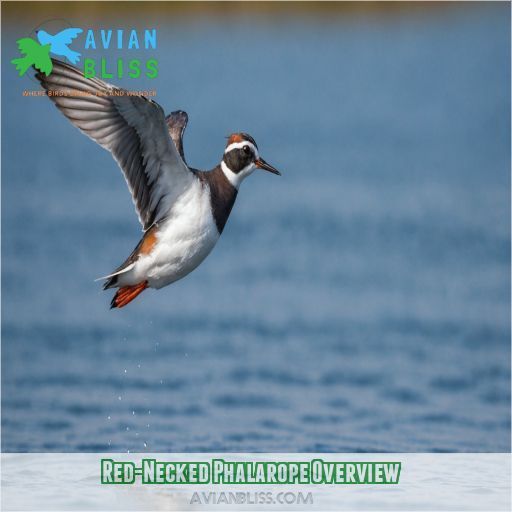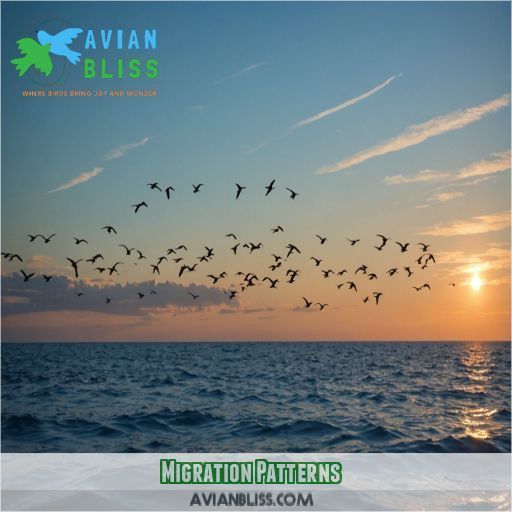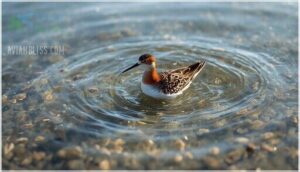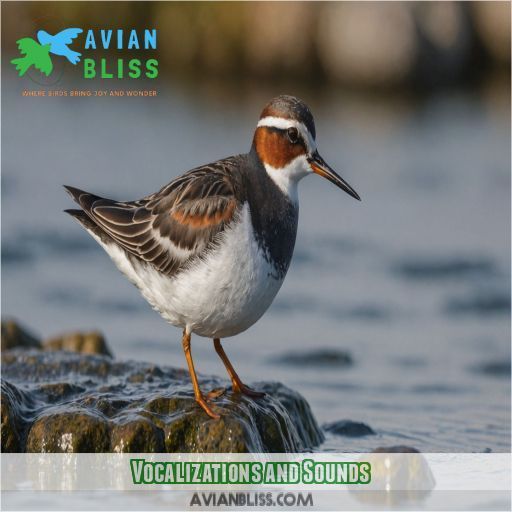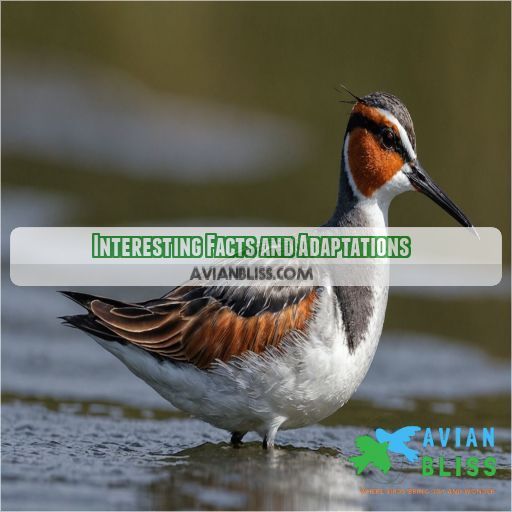This site is supported by our readers. We may earn a commission, at no cost to you, if you purchase through links.
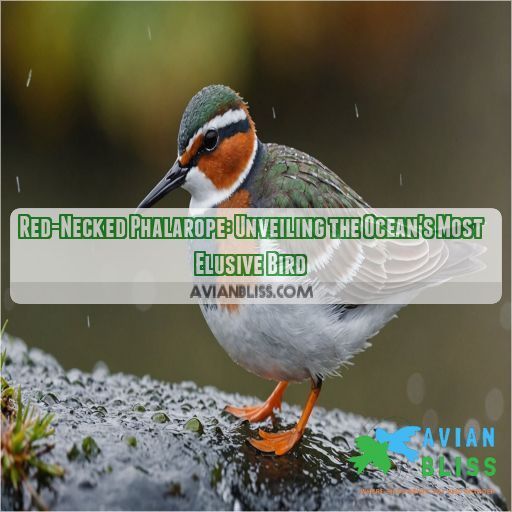
Table Of Contents
- Key Takeaways
- Red-Necked Phalarope Overview
- Physical Characteristics
- Migration Patterns
- Diet and Foraging
- Breeding and Nesting
- Conservation Status
- Vocalizations and Sounds
- Biometric Differences
- Interesting Facts and Adaptations
- Frequently Asked Questions (FAQs)
- What are the cool facts about Red-necked Phalaropes?
- Where do Red Phalaropes live?
- How big is a red-necked phalarope?
- Do phalarope migrate?
- How do Red-necked Phalaropes adapt to different aquatic environments?
- What is the role of male Red-necked Phalaropes in incubation?
- How do Red-necked Phalaropes protect themselves from predators?
- What is the average lifespan of a Red-necked Phalarope?
- How do Red-necked Phalaropes communicate with each other?
- Conclusion
Key Takeaways
- You’ll be surprised to learn that these birds flip the script on traditional gender roles – females are larger, more colorful, and lead courtship, while males take on incubation duties. It’s as if Mother Nature decided to shake things up a bit!
- These tiny travelers are marathon flyers, migrating up to 10,000 km non-stop across oceans. They’re the avian equivalent of ultra-marathoners, but instead of relying on energy gels, they fuel up on tiny crustaceans.
- You’ll find these adaptable birds in a variety of aquatic environments, from Arctic tundra to open oceans. They’ve mastered the art of spinning in circles to create whirlpools and catch prey – it’s as if they’re nature’s living blenders!
- Despite their small size (only 8-9 inches long), these birds face significant challenges. Climate Change and habitat loss are causing population declines, making conservation efforts crucial. Every time you reduce your carbon footprint, you’re giving these little fighters a helping hand.
Red-Necked Phalarope Overview
When you start learning about the Red-Necked Phalarope, you’ll discover a bird that defies conventions – females are larger and more colorful than males, and they lead the courtship dance. Found in the arctic tundra and open ocean, these birds are a fascinating sight, with their distinctive red necks and remarkable adaptations to their environment.
Unique Characteristics
Get ready to meet the red-necked phalarope, a bird that’s breaking all the rules! In a shocking reversal of roles, females are larger and more colorful than males, taking the lead in courtship rituals. These ocean-adapted birds spin in circles to forage for food and nest in the harsh Arctic tundra, showcasing their incredible adaptability and unique characteristics.
Habitat and Distribution
As you explore the Red-Necked Phalarope’s unique characteristics, you might wonder where these birds call home. Their habitat and distribution are quite fascinating! They breed in the Arctic tundra (Source), migrate through shallow ponds, and winter at sea . Here are some interesting facts about their habitat and distribution:
- They spend up to nine months at sea
- They nest in the low Arctic, on tundra ponds with marshy shores and bogs
- They gather at hyper-saline lakes during migration
Identification and Range
You’re ready to spot the elusive Red-necked Phalarope, but how do you identify it? Look for a gray back, white belly, and distinctive black patch on its face. Its range spans the arctic tundra and open ocean, with migrants passing through both North American coasts. Note its unique courtship behaviors and whirring calls to confirm the sighting.
Physical Characteristics
You’re about to meet the Red-Need Phalarope, a bird that’s as fascinating as it’s elusive. Let’s take a closer look at its physical characteristics, from its distinctive size and plumage to its striking color patterns and bill shape, and discover what makes this ocean-dwelling bird so unique.
Size and Plumage
As you get to know the Red-Necked Phalarope, you’ll notice their distinctive size and plumage.
Females are larger and more colorful than males, sporting a vibrant neck patch during breeding season.
Males, on the other hand, have more subdued tones.
Their feathers undergo significant changes during molting, adapting to seasonal demands.
This remarkable transformation is a clear example of their incredible adaptability.
Color Patterns and Markings
As you take a closer look at the Red-Necked Phalarope, you’ll notice its stunning color patterns and markings. During breeding season, females sport a more vibrant plumage than males, with a reddish-brown neck and white throat patch. Sex differences in plumage variation make identification challenging, especially during molting patterns. Luckily, supplementary materials like sound recordings can aid in identification.
Bill Shape and Size
As you get to know the Red-Necked Phalarope, you’ll notice its distinctive bill shape and size.
The bill is relatively small and slender, perfect for snatching tiny crustaceans and plankton from the water’s surface.
Notably, research shows that bill length doesn’t vary much between western and eastern birds, unlike wing length, which is longer in western birds for more efficient migration.
Migration Patterns
As you explore the fascinating world of the Red-Necked Phalarope, you’ll discover that their migration patterns are as intriguing as they’re impressive. From autumn to spring, these birds undertake incredible journeys, with western birds traveling over 10,000 km to reach their wintering grounds in the Pacific Ocean, while eastern birds take a shorter route to the Arabian Sea.
Autumn Migration Strategies
You’re now following the Red-Necked Phalarope on its autumn migration journey! As these birds depart their Arctic breeding grounds, they employ clever fueling strategies, making multiple stops to refuel . Timing variation is key, with western birds departing earlier and taking longer routes (Source). Habitat selection is also important, with birds choosing areas rich in food to sustain their long journey .
Spring Migration Strategies
As the days get longer, Red-Necked Phalaropes start their spring migration.
You might wonder, what’s the strategy behind this incredible journey?
Western birds depart from their wintering grounds around the same time as eastern birds, but they cover a greater distance and have a higher migration speed.
They make a longer first leg, too, and stage for shorter durations at stopover locations.
Winter Movement Strategies
You’re now entering the winter wonderland of Red-Necked Phalaropes. As you follow these birds from their spring migration, you’ll notice that their winter movement strategies are influenced by ocean productivity . Western birds tend to be more stationary, using fewer staging areas, while eastern birds cover more distance . This migratory divide has biometric correlations, with western birds having longer wings .
Diet and Foraging
The Red-Necked Phalarope’s diet and foraging habits are as intriguing as their unique mating rituals.
These birds have adapted to thrive in a wide range of aquatic environments.
They spin in circles to catch small prey in shallow waters.
They also feed on tiny crustaceans and mollusks in the open ocean.
Food Sources and Preferences
You’re about to learn about the fascinating world of Red-Necked Phalarope’s food sources and preferences! These birds mainly feast on small prey like insects, crustaceans, and mollusks. Their diet varies with season and habitat, from brine shrimp in summer to tiny crustaceans in winter. They adapt to their surroundings, making them expert foragers in both tundra pools and open oceans.
Foraging Techniques and Behaviors
You’re about to enter the fascinating world of Red-Necked Phalarope foraging techniques. These birds have adapted unique strategies to catch their prey. Here are a few:
- Whirlpool foraging: They create whirlpools in shallow water to stir up food particles.
- Shallow water foraging: They feed on small invertebrates in shallow pools.
- Oceanic food search: They search for food in the open ocean, often feeding on brine shrimp.
Seasonal Variations in Diet
The Red-Necked Phalarope’s diet varies significantly throughout the year.
During breeding season, they primarily consume insects and crustaceans in the Arctic tundra.
As they migrate, their diet shifts to include small fish and plankton.
In the open ocean, they prefer copepods and krill.
These foraging behavior changes ensure optimal nutrient intake, adapting to food availability and prey preferences.
Breeding and Nesting
You’re about to enter the fascinating world of Red-Necked Phalarope romance and parenting. As you explore the breeding and nesting habits of these remarkable birds, you’ll discover the unique roles females play in courtship, the males’ dedicated parental care, and the clever ways they adapt to their Arctic tundra homes.
Courtship and Mating Behaviors
You’re about to witness a courtship spectacle like no other – the female-led dance of the Red-Necked Phalarope!
In a role reversal, females take the lead, flaunting their vibrant plumage and performing an aerial ballet to woo reluctant males.
This unique mating ritual is a key factor in their polygamous lifestyle, with females often seeking multiple partners to boost their chances of successful reproduction.
Nesting Habits and Egg-Laying
Now that you’ve witnessed the unique courtship dance of the Red-Necked Phalarope, let’s take a peek at their nesting habits. Female phalaropes select a nest site near water, often on a small island or a piece of floating vegetation. They lay a clutch of 3-4 eggs, which the male will incubate for about 20 days.
Parental Care and Incubation
Now that we’ve explored the Red-Necked Phalarope’s nesting habits, let’s talk about who’s really doing the heavy lifting – the dads! In a unique role reversal, males take on incubation duties, balancing eggs on their feet while females fly off to find their next mate. This remarkable male-led incubation period can last up to 19 days.
Conservation Status
As you learn about the Red-Necked Phalarope’s remarkable adaptations and behaviors, you’ll also discover the pressing concerns surrounding its conservation status. The species faces significant threats from climate change, and its population declines are a pressing issue that requires our attention and action to protect these incredible birds.
Climate Vulnerability and Threats
As you’ve learned about the Red-Necked Phalarope’s unique breeding habits, you might wonder what threatens their existence. Climate change is a major culprit, altering their habitat and disrupting food supplies. Human activities like pollution and coastal development also harm these birds. It’s time to acknowledge the impact of our actions and develop conservation strategies to protect them.
Population Declines and Trends
How’s the Red-Necked Phalarope doing, population-wise? Sadly, it’s not great. Studies suggest population declines, likely due to climate change and habitat loss. Conservation challenges abound, and the future looks uncertain. While some populations seem stable, others are dwindling fast. To better understand these trends, researchers are tracking migration patterns, breeding habits, and habitat conditions.
Conservation Efforts and Strategies
As you’ve learned about the Red-Necked Phalarope’s declining population, you’re probably wondering what’s being done to help. Conservation efforts are underway, including habitat restoration, population monitoring, and climate adaptation strategies. Citizen science projects and funding sources like the Migratory Birds Convention Act are also essential in protecting this species. Every small action counts in safeguarding their future.
Vocalizations and Sounds
You’re about to enter the fascinating world of Red-Necked Phalarope vocalizations, where you’ll discover the unique sounds that help researchers and bird enthusiasts alike identify these elusive birds. From alarm calls to flight calls, you’ll get to explore the various recordings that showcase the remarkable range of sounds made by this incredible species.
Call Types and Descriptions
When you learn about Red-Necked Phalarope vocalizations, you’ll discover a variety of call types that’ll keep you fascinated. Let’s break it down:
- Alarm calls: loud, high-pitched warnings to alert others of potential threats
- Flight calls: short, melodic chirps to maintain contact during migration
- Breeding calls: soft, whirring sounds used by females to lure males during courtship
Recording Locations and Data
Now that you’re familiar with the various call types and descriptions of the Red-Necked Phalarope, let’s explore where these sounds were recorded. From Malaysia to Iceland, Finland to Kazakhstan, researchers have collected 156 foreground recordings and 25 background recordings, totaling 1 hour and 49 minutes of audio. This diverse dataset offers a unique glimpse into the bird’s vocal behavior across its global range.
Accessing Sound Recordings
You’re now ready to tune in to the Red-Necked Phalarope’s sound recordings! With 156 foreground recordings and 25 background ones, you’ll get to eavesdrop on their calls, alarm calls, and even wingbeats. Access these recordings through online databases, like AVoCet or the provided links, and get ready to become a Phalarope sound expert!
Biometric Differences
You’re about to enter the fascinating world of biometric differences in Red-Necked Phalaropes, where you’ll discover the subtle yet significant variations in physical characteristics that set these birds apart. Get ready to explore the intriguing distinctions in wing length, tarsus length, and bill shape that have adapted to the demands of their extraordinary migratory journeys.
Wing Length and Tarsus Length
Now that we’ve explored the fascinating world of Red-Necked Phalarope vocalizations, let’s take a closer look at their wings and legs.
Research has shown that western birds have longer wings and tarsi than their eastern counterparts.
This biometric variation likely enhances flight efficiency for those long Pacific migrations.
It’s amazing how these small differences can add up to make a big impact on their travels!
Bill Length and Shape
Now that we’ve explored the fascinating world of wing lengths and tarsus lengths, let’s talk about the Red-Necked Phalarope’s bill length and shape. Bill length doesn’t differ much between western and eastern birds. However, the bill’s shape plays a key role in foraging adaptations, allowing these birds to skillfully snatch prey from the water’s surface.
Geographic Variations in Biometrics
Now that we’ve talked about bill length and shape, let’s look at how biometrics vary across different geographic locations. You’ll notice that western Red-Necked Phalaropes have longer wings and tarsi than their eastern counterparts. This variation is likely due to selection pressures from their migration routes, with western birds traveling longer distances over open ocean.
Interesting Facts and Adaptations
The Red-Necked Phalarope is a bird that defies conventional norms.
It has unique roles and behaviors, remarkable adaptations to open ocean environments, and impressive long-distance migration abilities.
From females leading courtship to males incubating eggs, the Red-Necked Phalarope’s roles are reversed.
This bird also has fascinating adaptations, such as spinning in circles to catch prey.
The Red-Necked Phalarope is an impressive long-distance migrant, traversing thousands of miles each year.
This bird’s intriguing facts and adaptations will captivate and inspire you.
Unique Roles and Behaviors
The Red-Necked Phalarope’s unique roles and behaviors will fascinate you.
Females take the lead in courtship, flaunting their colorful feathers to win over males.
But here’s the twist: males incubate the eggs and care for the young.
Meanwhile, these birds have mastered the art of spinning foraging, a clever trick to snag food in shallow waters.
Adaptations to Open Ocean Environments
As you explore the Red-Necked Phalarope’s adaptations to open ocean environments, you’ll discover some remarkable features . Their water-resistant feathers keep them dry and insulated , while a special salt gland helps remove excess salt from their bodies . They’re also skilled at deep diving and ocean foraging , making them well-suited to their aquatic lifestyle.
Long-Distance Migration Abilities
You’re about to meet a bird that’s a master of long-distance travel! The Red-Necked Phalarope migrates thousands of miles each year, crossing entire oceans. Here are three mind-blowing facts about their migration abilities:
- They travel up to 10,000 km non-stop over the Pacific Ocean.
- They use fueling strategies, like eating tiny crustaceans, to sustain their journeys.
- They navigate using the stars, sun, and even magnetic fields.
Frequently Asked Questions (FAQs)
What are the cool facts about Red-necked Phalaropes?
You’re about to meet a bird that’s a total rebel! Imagine a species where females are larger and more colorful, leading courtship, while males take care of the eggs and young – say hello to some amazing cool facts!
Where do Red Phalaropes live?
You’re wondering where Red Phalaropes live? Well, these amazing birds call the Arctic tundra home during breeding season, while wintering at sea, mainly south of the equator off western South America – talk about a dramatic change of scenery!
How big is a red-necked phalarope?
Imagine spotting a tiny bird on your next beach trip! You’ll be surprised to know that the red-necked phalarope is only about 8-9 inches (20-23 cm) long, with the females being slightly larger than the males.
Do phalarope migrate?
You’re curious about phalarope migration? Well, these birds are quite the travelers! They migrate across vast distances, with some populations traveling over 10,000 km each way, crossing entire oceans and continents .
How do Red-necked Phalaropes adapt to different aquatic environments?
You’re about to learn about the amazing world of adaptation! Red-necked Phalaropes thrive in diverse aquatic environments with their unique lobed toes, spinning foraging tactics, and reversed sex roles, allowing them to conquer everything from Arctic tundra to open oceans.
What is the role of male Red-necked Phalaropes in incubation?
You might be surprised, but in some bird species, males take on a key role in incubation. As it happens, males of a certain species are responsible for keeping eggs warm and safe until they hatch.
How do Red-necked Phalaropes protect themselves from predators?
When in Rome, do as the Romans do" – blend in to survive! You see, to protect themselves from predators, they rely on their exceptional camouflage, freezing in place to avoid detection, and using their speed to make swift escapes.
What is the average lifespan of a Red-necked Phalarope?
You’ll find that these hardy birds typically live 5-10 years in the wild. They’re resilient little flyers, but life’s no picnic when you’re dodging predators and braving harsh weather. It’s a phalarope’s life!
How do Red-necked Phalaropes communicate with each other?
You’ll hear Red-necked Phalaropes chattering away with various calls. They’ve got a repertoire of sounds, from alarm calls to flight calls. During courtship, females even perform whirring wing displays to catch a mate’s attention. Pretty chatty birds!
Conclusion
As the saying goes, "Don’t judge a book by its cover."
The red-necked phalarope proves this adage true, defying expectations at every turn.
You’ve discovered a bird that’s as fascinating as it’s elusive, with its unique gender roles, incredible migrations, and remarkable adaptations.
From Arctic tundras to open oceans, these tiny travelers have captured our hearts and imaginations.
Next time you’re near coastal waters, keep your eyes peeled – you might just spot a red-necked phalarope spinning its way through life’s adventures.

